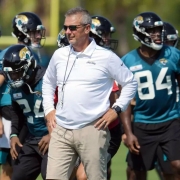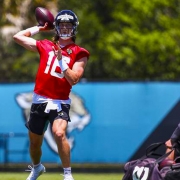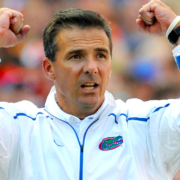A Galaxy of Difference
About every third time Jaguars Head Coach Urban Meyer meets with the media, he references how he’s learning the pro game. He admits he is surprised by some things and has hired a staff full of coaches with NFL experience to shepherd him through the process.
While I admire the transparency, never Meyer’s strong suit, just how many things are different between the NFL and the college game? And at what point can it make a difference between wins and losses?
In the first ever Jaguars game at home in 1995 against the Houston Oilers, some of the nuanced differences between the two games were on full display.
“Will the chain gang please report to the field,” the PA announcer said as the teams lined up for the second half kickoff. The guys holding “the sticks” had done so many college games at our stadium it caught them off guard how quickly the NFL halftime goes.
Officially, the mid-game break in the NFL is twelve minutes from the time the last coach or player leaves the field. The game is run by television, and they have a schedule to keep. In college, the halftime is scheduled for fifteen minutes and often last up to twenty. The chain gang was still sitting in the lunchroom while the referee was ready to blow the whistle.
When you look at a drive sheet from an NFL game, you can see where the outcome turns on just a couple of plays. That’s new for Meyer.
“I can’t stand bad plays,” he said after the Jaguars first exhibition loss to the Browns. “It is even magnified now because you just don’t have that many plays.”
Last year NFL teams averaged between sixty and seventy offensive plays per game. The Jaguars averaged just over sixty-two, seventh fewest in the league. College offenses can average more than eighty snaps. Clemson had just over seventy-eight plays on average last year, fifteenth most among college teams.
“I remember looking up and was like, my gosh, we’re in the middle of the second quarter and we’ve had three drives,” Meyer said, admitting to being surprised Saturday night. “In college, you have three drives in the first quarter or four if you are really cooking. I knew that, but now that I did it, it’s on you quick.”
Meyer has spoken often about the roster limitations in the NFL and having to cut nearly half of the players who are in camp to get down to fifty-three on opening day. The Jaguars staff meets regularly about “roster management” and Meyer admitted having that limitation led to the Jaguars cutting Tim Tebow.
“It comes down (to that) because we expect to be very good on special teams,” he said, explaining that special teamers have to both block and tackle, things Tim hadn’t done in a while. “The tight end position is one of those (positions) and tailback. If you can’t contribute on special teams, that’s a tough go.”
It will be different for Meyer when he walks on the field at Houston on September 12th if only for the amount of talent on every roster in the league. For the first time in his coaching career, probably since he left Utah in 2004, Meyer will not have the best team on the field. Certainly, at least in his first year here, every time Meyer steps through the tunnel, the team on the other sideline will be at least as talented as the Jaguars.
In addition, at every college stop, Meyer had eighty or ninety players to choose from on Saturday. On NFL Sunday’s, he’ll have about half that number. And just getting down to a game day roster is full of difficult decisions.
“I’ve been warned by colleagues that you know that’s going to be a tough deal,” he explained. “I just start thinking about these guys careers. We can’t be wrong. It’s not fair to that player.”
More than once Meyer has lamented the size of the roster and with cuts looming in the near future, he admits he’ll be leaning on the coaches on his staff who have been around the league.
“How do you actually practice with fifty-three veteran players?” he asked. “I can handle the college game pretty good. It’s a little different animal here. Those are all things I don’t think college guys know. College guys know how to motivate and run an organization. But for that kind of intricacies (practice plans, roster management), you need to have people around you. And I do.”
While the transition from the college to pro game is littered with coaches who didn’t make it, there are some who have adapted with great success. Tom Coughlin was a winner at Boston College before taking the Jaguars job. Barry Switzer, Jim Harbaugh, Bill Walsh, and Pete Carroll all had success at both levels. Jimmy Johnson might be the most successful coach who’s won championships in college and in the NFL.
“There’s not a world of difference, there’s a galaxy of difference,” Johnson told a Miami newspaper before his induction this year into the Pro Football Hall of Fame. “As a college coach, I was a mentor, I was kind of a father figure, I did a tremendous amount of counseling with the players.”
Johnson believes players in the professional game are motivated and dictated by financial pressures, creating a completely different coach/player relationship.
And he agreed, sometimes you just “out-talent’ the other team in college.
“Sometimes I didn’t even need to show up we had so much talent,” he said of his time at the University of Miami. “You’re gonna have to be at your best for maybe three games a year (in college). In professional football, it’s really a different world.”
While college coaches have massive staffs, hold sway over the school at large, and make significantly more money than their bosses, they also must deal with academics, alumni and growing young men.
In the NFL they’re coaching adults. They have to deal with one person: The Owner.
And they have one job: Win.
“He doesn’t need to know what the goals and ambitions of these young men are,” Barry Switzer told Sam Farmer of the Los Angeles Times. “He doesn’t need to know [a player’s] mother. He doesn’t need to know if he had a father in the home, or if he had any siblings. All those things are irrelevant. That player might be in camp one day and on the waiver wire the next one, and the coach will never speak to him or see him again the rest of his life.
“A college coach sees every player — when you recruit a player, you’ve got him for life. You can wrap that up with one sentence.”
About a month ago, Meyer revealed that he doesn’t expect to change much from his days at Florida and Ohio State.
“I think you win for your coach and the coaches coach for their players,” he said of his philosophy. “I know they get paid now and I’ve heard all about “pro.” I don’t necessarily buy that. I believe in relationships. I believe that these are not number 75 or number 72, they’re people and that’s one of the reasons we’ve had success over the years.”
Will that work in the NFL? Will grown men buy into that when their livelihood is on the line? Will Meyer see it differently as his NFL career progresses?
Barry Switzer has lived through it:
“The job of a professional coach is to win football games with 53 players, and his only goal is the Super Bowl.”





